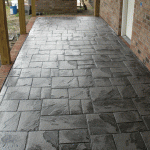Being one of only a few licensed Chicago Concrete Contractors doing estimates for clients in the Chicagoland area and showing pictures of completed work, I always get the ooh’s and aah’s when they see the stamped concrete pictures. Then, when the prices are figured the first questions are, “Why is it so expensive?” and “What is so different about stamped concrete compared to regular concrete?”
So, why is stamped concrete so expensive? Well, to start off with, it takes a bit more planning to pull everything off for the big day. The client needs to pick out three things; the stamp design, the integral color of the concrete, and the color of the release which gives the highlights. The next step for the contractor depends on if the contractor owns their own stamps or needs to rent them. Chicagoland Concrete, Inc. does own their own stamps and makes this step easier as the alternative is renting them. Renting becomes a problem for contractors because the stamps are not always available when the job requires them. It can also be cost prohibitive to purchase a set of stamps as they can run upwards of $2,000-$3,000 for a complete set. The next issue at hand is ordering the concrete and either coloring it in the truck on-site, or ordering it straight from a ready-mix supplier if the supplier stocks the required color and then paying a hefty premium. There is also an additional charge that the ready-mix supplier charges for a special mix that reduces certain additives that won’t react to the integral coloring, on top of a charge to wash out the truck. If you mix the integral color on site, you will be adding waiting time to the ticket which in the Chicagoland market runs about $3/min. When the colored concrete is placed, it is finished smooth just like normal concrete then a release color (think of powdered sugar) is spread on the surface of the concrete serving a dual purpose. The release allows the stamp to peel off the surface while not sticking to the wet concrete and also impregnates the concrete with the secondary color. Once the concrete has cured, usually the next day, the crew returns and washes off the excess release from the concrete. Then next step is to wait till the water evaporates completely off. Then a special sealer is used to protect the surface and bring out the color, usually two to three coats is needed to ensure proper coverage.
pick out three things; the stamp design, the integral color of the concrete, and the color of the release which gives the highlights. The next step for the contractor depends on if the contractor owns their own stamps or needs to rent them. Chicagoland Concrete, Inc. does own their own stamps and makes this step easier as the alternative is renting them. Renting becomes a problem for contractors because the stamps are not always available when the job requires them. It can also be cost prohibitive to purchase a set of stamps as they can run upwards of $2,000-$3,000 for a complete set. The next issue at hand is ordering the concrete and either coloring it in the truck on-site, or ordering it straight from a ready-mix supplier if the supplier stocks the required color and then paying a hefty premium. There is also an additional charge that the ready-mix supplier charges for a special mix that reduces certain additives that won’t react to the integral coloring, on top of a charge to wash out the truck. If you mix the integral color on site, you will be adding waiting time to the ticket which in the Chicagoland market runs about $3/min. When the colored concrete is placed, it is finished smooth just like normal concrete then a release color (think of powdered sugar) is spread on the surface of the concrete serving a dual purpose. The release allows the stamp to peel off the surface while not sticking to the wet concrete and also impregnates the concrete with the secondary color. Once the concrete has cured, usually the next day, the crew returns and washes off the excess release from the concrete. Then next step is to wait till the water evaporates completely off. Then a special sealer is used to protect the surface and bring out the color, usually two to three coats is needed to ensure proper coverage.
To sum everything up, the coordination of renting the stamps, purchasing the coloring, the release, paying for the extra waiting time, paying a washout charge, extra labor to stamp the concrete after finishing, the second day to wash off the release, and then applying the sealer add up quickly. It typically adds up to the tune of about 50% over the cost of traditionally placed concrete. Is the additional cost worth it? In my personal opinion, Yes, It adds value and sets your driveway, sidewalk, or patio apart from the miles of other plain concrete in your typical neighborhood. It also is a lot less maintenance and is cheaper than brick pavers which most people see as the alternative.
We hope this article helps you to understand some of the logistics involved to bring you the completed stamped concrete product.
-Chicagoland Concrete, Inc.
well written blog. Im glad that I could find more info on this. thanks
This is such a great resource that you are providing and you give it away for free. I enjoy seeing websites that understand the value of providing a prime resource for free. I truly loved reading your post. Thanks!